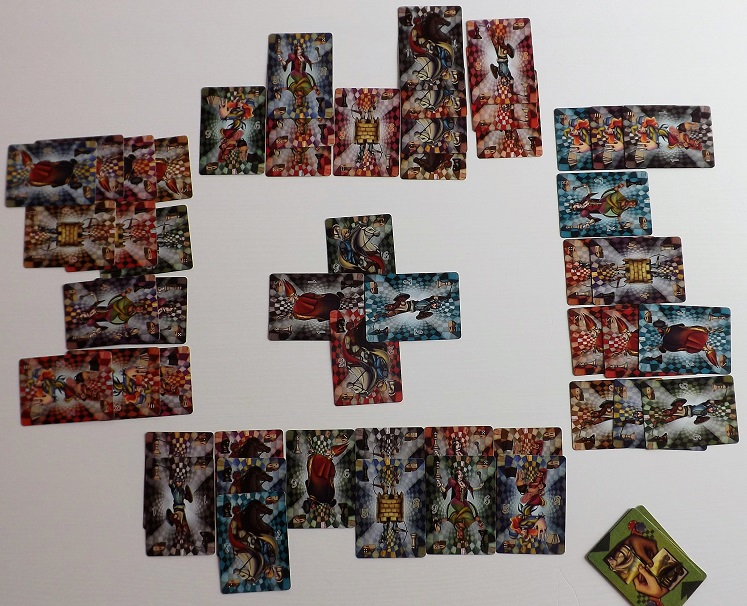TriumfDrez
This game is similar to many in that the players, during their turn, throw one of their cards that will compete with the one thrown by the rest.

The Game
This game is similar to many in which players, during their turn, throw one of their cards that will compete with the one thrown by the rest.
The player with the most powerful card of all those thrown in that turn will win that trick.
The objective of the game is to win as many tricks as possible.
It will be played with a single deck of 56 cards.
Two, three or four players can play, in the latter case it will be played in pairs who will sit opposite each other.
In any of the variants each player will receive 13 cards at the beginning of the game. The remaining cards will remain face down all the time.
During a trick the first player can choose the card they want to start with, but the rest of the players are obliged to throw cards of the same figure as the one thrown by the first player as long as they have at least one of them.
The trick will be won by the card with the highest number, according to the color, of the same figure thrown by the first player. Cards of a different figure to the initial one, even if they have a higher hierarchy or numbering, will not be able to win the trick (as long as they are not trumps).
Normally (it will be explained later when it is not the case) there will be a figure that will be the trump and a color that will be a supertrump (it will be explained below how they are chosen).
When a player does not have any card of the initial figure they can also, if they wish, throw a trump card that will beat any card that is not a trump or a card of the color of the supertrump, which will beat even any other trump card.
Among trumps, the one with the highest numbering will win. Among supertrumps, the one with the highest hierarchy will win, taking into account the following order from highest to lowest: Joker, Queen, Rook, Bishop, Knight, Pawn.
The card of the figure of the trump and the color of the supertrump will be the most powerful card of the entire deck in that game.
The player who wins a trick will start the next one.
A player is not obliged to try to win a trick, that is, even if they have cards of higher numbering or trumps they can reserve them for later use as long as they comply with the rule of serving the initial figure.
Example where the trump is the bishop and the supertrump is cyan:
- If in a trick a player starts with a green knight all players will have to throw knight cards as long as they have them.
- The second player does not have knights and throws a bishop, which is a trump, so he is winning the trick at the moment.
- The third player throws a red knight (he has to serve the knight, even though he already knows he is going to lose the trick).
- The last player also does not have knights and throws a cyan pawn that being the color of the supertrump beats even the bishop trump and wins the trick

Determination of the Trump
At the beginning of the game, each player can try to impose the figure of the trump and the color of the supertrump to be used according to the cards they have been dealt.
To do this, the first player (the next one to the right of the one who has dealt the cards) must indicate a figure to be used as a trump and a color as a supertrump and the number of tricks they intend to win if they are the winner of this phase of proposals.
The following players, in order, must pass (desist from making any proposal) or increase the number of tricks proposed by the previous player proposing their own figure and color as trump and supertrump respectively.
A player can also improve the proposal of the previous player (without having to increase the number of tricks to win proposed) if they propose to play without trumps, without supertrumps or even, without either of the two.
Finally, without having to increase the number of proposed tricks (with or without trumps and supertrumps) a player (or pair) will have priority over others if they declare that they will play with their cards revealed.
When, after a player’s proposal, none of the others dare to increase their proposal, they will be the winner of this phase and will begin the game phase explained above with a figure trump and color supertrump (or without them) that they have chosen.
If this player, or pair, manages to fulfill the number of tricks committed or more, they will have won the game. Otherwise, they will have lost it.
Example:
- The first player says they will win eight tricks if the trump is the knight and the supertrump is blue
- The second player says they will win nine if the trump is the bishop and the supertrump is red, thereby surpassing the first.
- The third player claims they will also win nine tricks without using trumps, but with green supertrumps, thus improving the proposition of their predecessor
- The fourth player predicts they will win nine tricks without trumps and with the cyan supertrump and with their cards (and their partner’s) open. This beats the proposition of the third player.
- The first player decides to increase to ten tricks with a knight trump and the blue supertrump.
- None of the other players dare to increase this prediction, so the game begins with the conditions imposed by the winner of this phase.
The pair of the first and third player must therefore win at least 10 of the 13 tricks to be considered winners. They will not need to show their cards because that condition was not introduced in their last winning proposition.
Scoring
Each game will have the score corresponding to the number of tricks committed. Each trick not achieved or that exceeds the initial proposed amount will count double extra points.
If the player or pair achieves their goal, they will receive that number of points, if they do not achieve it, the opposing players will receive them.
Example: if a player wins the trump with a proposal of 8 tricks and achieves 10 then they will receive 12 points: 8 for the proposed tricks and 4 more for the two extra tricks. If instead they had only obtained 7 tricks then their opponents would receive 10 points each: 8 for the value of the game and 2 extra for the trick they lacked to achieve their goal.
The first player or pair to reach a previously established number of points, for example, 50, will win.

